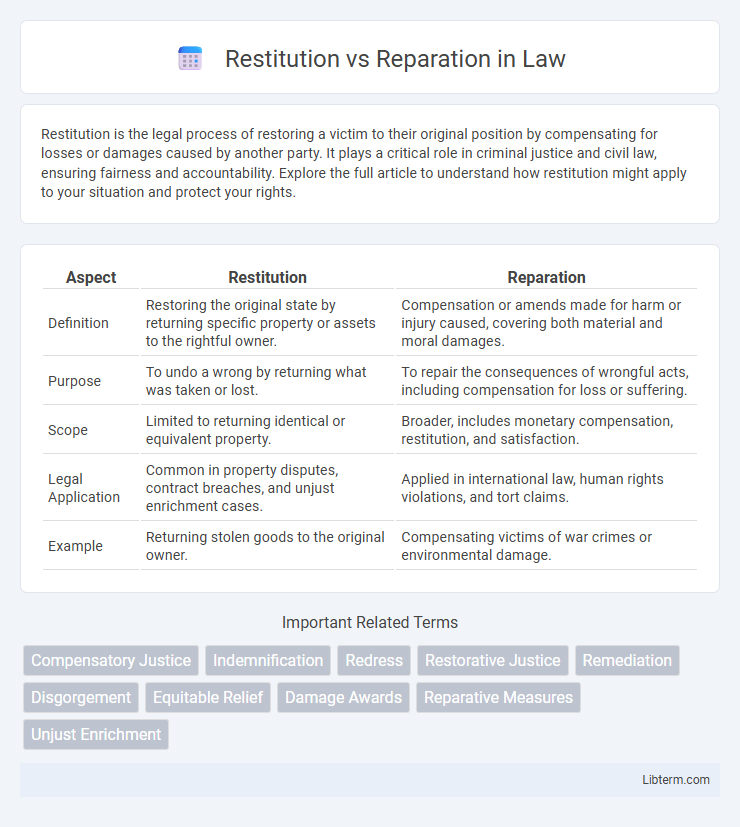Restitution is the legal process of restoring a victim to their original position by compensating for losses or damages caused by another party. It plays a critical role in criminal justice and civil law, ensuring fairness and accountability. Explore the full article to understand how restitution might apply to your situation and protect your rights.
Table of Comparison
| Aspect | Restitution | Reparation |
|---|---|---|
| Definition | Restoring the original state by returning specific property or assets to the rightful owner. | Compensation or amends made for harm or injury caused, covering both material and moral damages. |
| Purpose | To undo a wrong by returning what was taken or lost. | To repair the consequences of wrongful acts, including compensation for loss or suffering. |
| Scope | Limited to returning identical or equivalent property. | Broader, includes monetary compensation, restitution, and satisfaction. |
| Legal Application | Common in property disputes, contract breaches, and unjust enrichment cases. | Applied in international law, human rights violations, and tort claims. |
| Example | Returning stolen goods to the original owner. | Compensating victims of war crimes or environmental damage. |
Understanding Restitution and Reparation: Definitions
Restitution involves restoring a victim to their original position by returning stolen or wrongfully taken property, emphasizing the return of specific assets or compensation equivalent to the loss. Reparation encompasses a broader concept, including compensation, rehabilitation, and guarantees of non-repetition to address the harm caused by wrongful acts or injustices. Both aim to remedy violations, but restitution strictly concerns the restoration of possessions, while reparation covers various forms of redress for injury or damage.
Historical Contexts: Origins of Restitution and Reparation
Restitution originated in ancient legal systems where it aimed to restore victims to their original status before harm, often involving tangible property recovery or compensation. Reparation developed more broadly from post-conflict and transitional justice contexts, addressing not only material losses but also moral and psychological harm suffered by victims. Historical contexts reveal restitution's roots in classical jurisprudence, whereas reparation encompasses a modern framework for healing and justice in societies recovering from systemic injustices or war crimes.
Key Differences Between Restitution and Reparation
Restitution involves restoring the victim to their original state by returning specific property or its equivalent value, emphasizing the reversal of unjust enrichment. Reparation encompasses broader compensation, including monetary payments, apologies, or rehabilitation, aimed at addressing harm and promoting healing. While restitution focuses on correcting a specific loss, reparation covers comprehensive redress for moral, physical, or emotional damages.
Legal Perspectives: Restitution vs Reparation
Restitution in legal contexts involves restoring a victim to their original position by returning specific property or its value, often in contract or property disputes. Reparation extends beyond mere return, encompassing compensation for broader damages such as emotional harm or loss of rights, commonly seen in international law and human rights cases. Courts differentiate restitution as a remedy aimed at undoing unjust enrichment, while reparation addresses moral or social justice through reparative measures.
International Practices in Restitution and Reparation
International practices in restitution often involve the return of property or assets wrongfully taken during conflicts, exemplified by cases such as the return of cultural artifacts to their countries of origin. Reparation measures extend beyond restitution to include compensation, rehabilitation, and guarantees of non-repetition for victims of human rights violations, as seen in United Nations frameworks and transitional justice mechanisms. These practices reflect a comprehensive approach combining legal restitution with moral and compensatory reparations to address infractions under international law.
Case Studies: Real-World Examples
Restitution involves restoring stolen or lost property to its rightful owner, exemplified by the German government's return of art looted during World War II to Jewish families. Reparation focuses on compensating victims for harm suffered, as seen in South Africa's post-apartheid Truth and Reconciliation Commission, which provided financial and social reparations to marginalized communities. Both approaches highlight different legal and moral frameworks for addressing historical injustices through case studies worldwide.
Social and Ethical Implications
Restitution involves restoring or compensating for specific losses, typically aiming to reverse the impact of a wrong, while reparations address broader social and historical injustices through systemic compensation or recognition. Ethical implications of restitution emphasize individual justice and accountability, whereas reparations highlight collective responsibility and reconciliation within affected communities. Socially, reparations foster long-term healing and equity by acknowledging systemic harm, whereas restitution often targets immediate, tangible restitution for victims.
Restitution and Reparation in Transitional Justice
Restitution in transitional justice aims to restore victims to their original situation before a human rights violation occurred by returning property or rights unlawfully taken. Reparation encompasses a broader range of remedies, including restitution, compensation, rehabilitation, satisfaction, and guarantees of non-repetition to address the harms suffered. Effective transitional justice mechanisms prioritize restitution to directly remedy material losses and reparation to ensure comprehensive justice and reconciliation.
Challenges and Controversies
Restitution and reparation face challenges including quantifying harm, establishing liability, and addressing collective versus individual claims. Controversies arise over the adequacy of compensation, divergent victim expectations, and the political implications of acknowledging wrongdoing. Legal complexities and differing international standards further complicate the enforcement and legitimacy of restitution and reparation processes.
The Future of Restitution and Reparation
The future of restitution and reparation hinges on evolving legal frameworks and international cooperation to address historical injustices such as colonialism and slavery. Emerging policies emphasize restorative justice, including financial compensation, cultural heritage restoration, and institutional reforms to enable equitable redress for affected communities. Advances in digital documentation and global advocacy continue to drive transparency and accountability in restitution and reparation processes.
Restitution Infographic

 libterm.com
libterm.com